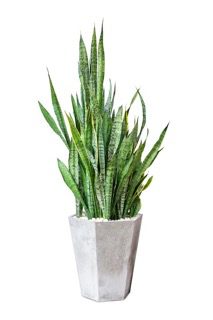
Snake plants (Sansevieria) are toxic to dogs. The plant contains saponins, which can cause gastrointestinal upset including vomiting and diarrhea if consumed by dogs. Ingestion may also cause drooling, nausea, and stomach pain. The leaves of the snake plant are the most toxic parts of the plant, but dogs should still be kept away from all parts of the plant as ingestion can be dangerous for them. If your dog eats a snake plant, it’s important to contact your veterinarian immediately. You should also try to identify what part of the plant your dog ate and provide them with plenty of water to help flush the toxins out of their system. In general, it’s best to keep snake plants out of reach of pets to prevent accidental ingestion and possible poisoning.
The Snake plant is a popular houseplant with origins in West Africa, Namibia, and Madagascar. It has a rich history of being used for medicinal purposes and fiber. Today, it is commonly used both indoors and outdoors for its air-purifying properties and low maintenance requirements.
Common symptoms of dog poisoning from snake plants include gastrointestinal upset such as vomiting and diarrhea, along with drooling, nausea, and stomach pain. Behavioral changes can also occur, such as lethargy and loss of appetite. Some visible signs of toxicity may include trembling, shaking, or seizures.
If you suspect your dog has been exposed to snake plants, the immediate actions to take include contacting your veterinarian right away and identifying exactly what part of the plant your dog ate. Providing plenty of water to help flush the toxins out of their system is also essential.
To prevent dogs from eating snake plants, it is best to keep them out of reach. Placing the plants in high places or areas where the dog cannot access them is ideal. You can also use deterrent sprays to keep pets away from the plants, or consider getting rid of the plant altogether if it poses too much of a risk.
If your dog does eat a snake plant, it is important to contact your veterinarian immediately. All parts of the plant, including the leaves and root, can be toxic to dogs, so it is crucial to seek help as soon as possible.
Do you own a Snake Plant (Sansevieria) or are you thinking about getting one? It’s important to know that they are toxic to dogs and can cause gastrointestinal upset, drooling, nausea, and stomach pain if consumed. To ensure the safety of your furry friend, we recommend checking out our website Way Canina, where you can compare different house plants to see which are the best options for your dogs. Remember, if your dog does ingest a snake plant, contact your veterinarian immediately and provide plenty of water to help flush the toxins out of their system. It’s always better to be safe than sorry, so keep snake plants out of reach of your pets.
If you’re a dog owner looking for some safe and non-toxic indoor plant options, you might want to consider the following:
– Spider plant (Chlorophytum comosum): This easy-to-care-for plant is known for its air-purifying properties and is safe for pets.
– Boston fern (Nephrolepis exaltata): This lush fern is a great way to add some greenery to your home and is non-toxic to dogs.
– Prayer plant (Maranta leuconeura): The vibrant colors and unique patterns of this plant make it a popular choice for indoor decoration, and it won’t harm your furry friend if they happen to nibble on it.
Thank you for reading our article on the dangers of snake plants to dogs. We hope that you found this information useful when it comes to ensuring the safety of your furry friends. At Way Canina, we prioritize the health and well-being of your pets, which is why we offer a wide range of healthy food ideas for dogs and other helpful information about their lifestyle. We invite you to visit our site again for more resources and tips, even if you don’t have the mentioned houseplant. Remember, prevention is always better than cure, so please keep your pets safe and avoid any unnecessary risks!
The Snake plant, also known as Sansevieria, is a popular houseplant that originates from West Africa, Namibia, and Madagascar. It is a member of the asparagus family, and it is known for its long, upright leaves that resemble snake skin. The plant has a rich history dating back to ancient times, where it was widely used for medicinal purposes and as fiber for clothing and rugs.
Today, the Snake plant is commonly used both indoors and outdoors. It is a popular choice for adding greenery to homes, offices, and other indoor spaces due to its air-purifying properties and low maintenance requirements. Outdoors, it is often used as a border plant and is drought-tolerant, making it ideal for xeriscaping in dry regions.
The Snake plant is popular worldwide, with particularly strong followings in tropical and subtropical regions such as Asia, Africa, and the Americas. Other common names for the plant include Mother-in-law's Tongue, Bowstring-hemp, and Devil's Tongue. People choose this plant for its attractive appearance, ease of care, and air-purifying properties, making it an ideal addition to any indoor or outdoor space.